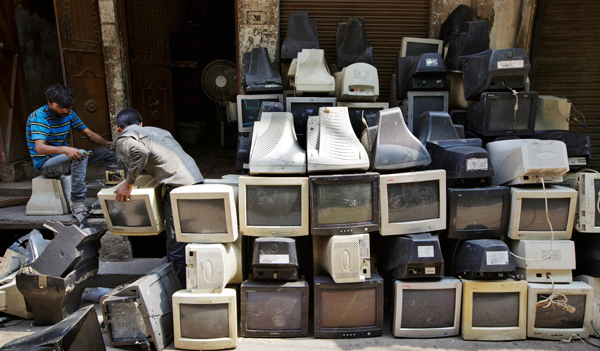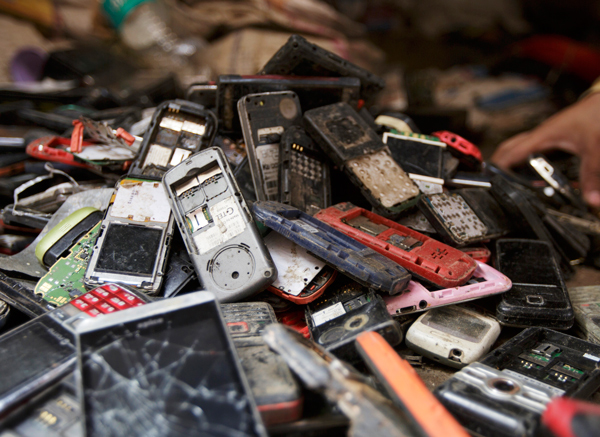Where does your iPhone go to die? Read. And be afraid.

India is sitting on a ticking e-waste time bomb. Technology has never sold faster. Mobile phones, televisions, laptops, tablets. Everyone across social and geographic strata is getting wired.
Technology, they say, will even save the environment.
But the dark side of the growth story has just begun to reveal itself. We are facing the onset of an unprecedented tsunami of electronic waste.
To say that discarded electronic appliances - if not recycled properly - can lead to pollution, toxicity, environmental damage and complications in human health would be an understatement.
As people go through electronics faster and faster, the problem gets harder to solve.
So what's the scale of India's e-waste? It's a scary answer.
Here's what the numbers say:
kilo tonnes
- That's how much e-waste was generated in India in 2014
- That's nearly four times the weight of the Empire State Building - a 102-storey skyscraper

Itu Chaudhuri Design/Catch News
- 70% of that mountain of e-waste is contributed by the public and private industrial sectors
- This contains over 1,000 different substances that are toxic - lead, arsenic, mercury and cadmium to name a few
- E-waste typically includes computer monitors, LCDs, air-conditioners, fridges, mobile phones, chargers, cathode rays tubes, motherboards etc
- The predicted increase of e-waste from televisions in India by 2020, according to a Rajya Sabha report
- Iron and steel make up 50% of e-waste from TVs; plastics account for around 21%
- Computers, televisions and mobile phones are the most dangerous. They have the maximum levels of cadium, lead and mercury and are discarded most often
- Individual households account for around 15% of India's e-waste

Workers dismantle used computer monitors in the capital. Photo: Kuni Takahashi/Bloomberg/Getty Images
- That's the rate at which e-waste from discarded mobile phones is expected to grow by 2020
kilo tonnes
- That's the estimated weight of electronic equipment that was put for sale in the Indian market in 2014
- That's nearly half the weight of the Great Pyramid of Giza
- Over 95% of e-waste is treated and processed in urban slums by untrained workers, without protective equipment
- The consequence: 76% of e-waste workers suffer from respiratory ailments such as asthma, bronchitis, and crippling immunities, says a study by ASSOCHAM (Associate Chambers of Commerce and Industry of India)
- Many children are employed in this sector. This affects both their nervous and respiratory systems. The hazardous exposure makes them unfit for any work by the time they are 35-40 years
- A stark example of how e-waste impacts children comes from Guiyu, a city in China that's the largest e-waste recycling site in the world: "80% of Guiyu's children experience respiratory ailments, and are especially at risk of lead poisoning," reads a report from a leading China daily
- That's how small a percentage of e-waste is recycled formally
- The rest is handled by the informal sector
- Delhi, currently in the news for air pollution, is the largest e-waste recycling market. Approximately 40% of e-waste lands here. Bangalore and Chennai are the next largest markets
- Attero Recycling Pvt Ltd, a Rs 35-crore government recycling plant in Roorkee that can process up to 36 lakh tonnes of e-waste each year, only gets to recycle 600 tonnes every year
- Is the amount of e-waste generated by Maharashtra annually - making it No. 1 among the states that are the worst e-waste offenders in the country
- Hypothetically, that's how much the collective weight of 15,000 Mangalyaan satellites would be
- Tamil Nadu comes in second with 13,486 tonnes. Andhra Pradesh a close third with 12,780 tonnes. Significantly, all three states are among the most industrial states in India
- 10 states in India generate around 70% of the country's total e-waste
- That's the growth of the electronics market in India over just five years: from $11.5 billion in 2004 to $32 billion in 2009
- In the same period, sales of computers increased from 0.3 million in 2004 to a whopping 6.7 million in 2009: a freakish growth of over 1000%
- But the problem is global: the last decade saw a 83% increase in sale of domestic appliances all over the world
- Or three-fourth of state bodies in India do not implement hazardous waste laws
- The generation of e-waste is growing annually at 10%
- Around 50 lakh tonnes of prohibited e-waste, municipal waste and clinical waste is imported annually in India
- Amit Mitra, Former Secretary-General of the Federation of Indian Chambers of Commerce and Industry, has warned: "Unrestricted imports of re-manufactured goods would adversely impact our domestic manufacturing sector and also have the risk of diluting safety standards and dumping of e-waste"

Photo: Kuni Takahashi/Bloomberg/Getty Images
rupees
- That's the value of the 3.5 million metric tonnes of scrap metals that enters India daily
- This means that the value of scrap metal reaching India daily is three times the cost of building the Bandra-Worli Sea Link
- This dumping of e-waste has continued despite India's signing of the Basel Convention on the Control of Transboundary Movements of Hazardous Wastes and their Disposal in the early 1990s
- The convention bans exchange of e-waste between developed and developing countries
- The US, which generates the maximum e-waste, is the only developed nation that has not ratified the Basel Convention
- The US and China combined are responsible for nearly a third of the world's e-waste
- India, China, Pakistan, Vietnam and the Philippines handle nearly 50-80% of global e-waste
- A majority of these e-waste imports are unusable computers, printers and keyboards that are more than 10 years old - a direct violation of the Hazardous Waste Rules, 2008

Itu Chaudhuri Design/Catch News
- Is the number of registered e-waste recyclers/dismantlers in the country
- These do not have the capacity to deal with the large amounts of imported e-waste
- That's the number of computers (more than eight years old) that became scrap in 2010 alone
- Additionally, manufacturers add 1,050 tonnes of e-waste each year
- Around 1,11,754 units in India manufacture electronics and electrical equipment, but 84,339 units are unregistered
- India ranks 155 out of 178 countries with regard to e-waste, according to the Environmental Performance Index, 2014
- India is also the fifth largest generator of e-waste in the world, according to the Global E-waste Monitor, 2014, and is among the top three Asian nations (after China and Japan)
- A successful model that can be followed is that of Austria, which recycles nearly 63% of the e-waste generated. The country has legislation for sustainable e-waste treatment that includes economic incentives for the producer, strict waste control and monitoring system and data management - balance sheet of e-waste collected and treated
- Sadly, India lacks such strong, much-needed deterrence measures







![BJP's Kapil Mishra recreates Shankar Mahadevan’s ‘Breathless’ song to highlight Delhi pollution [WATCH] BJP's Kapil Mishra recreates Shankar Mahadevan’s ‘Breathless’ song to highlight Delhi pollution [WATCH]](https://images.catchnews.com/upload/2022/11/03/kapil-mishra_240884_300x172.png)

![Anupam Kher shares pictures of his toned body on 67th birthday [MUST SEE] Anupam Kher shares pictures of his toned body on 67th birthday [MUST SEE]](https://images.catchnews.com/upload/2022/03/07/Anupam_kher_231145_300x172.jpg)






